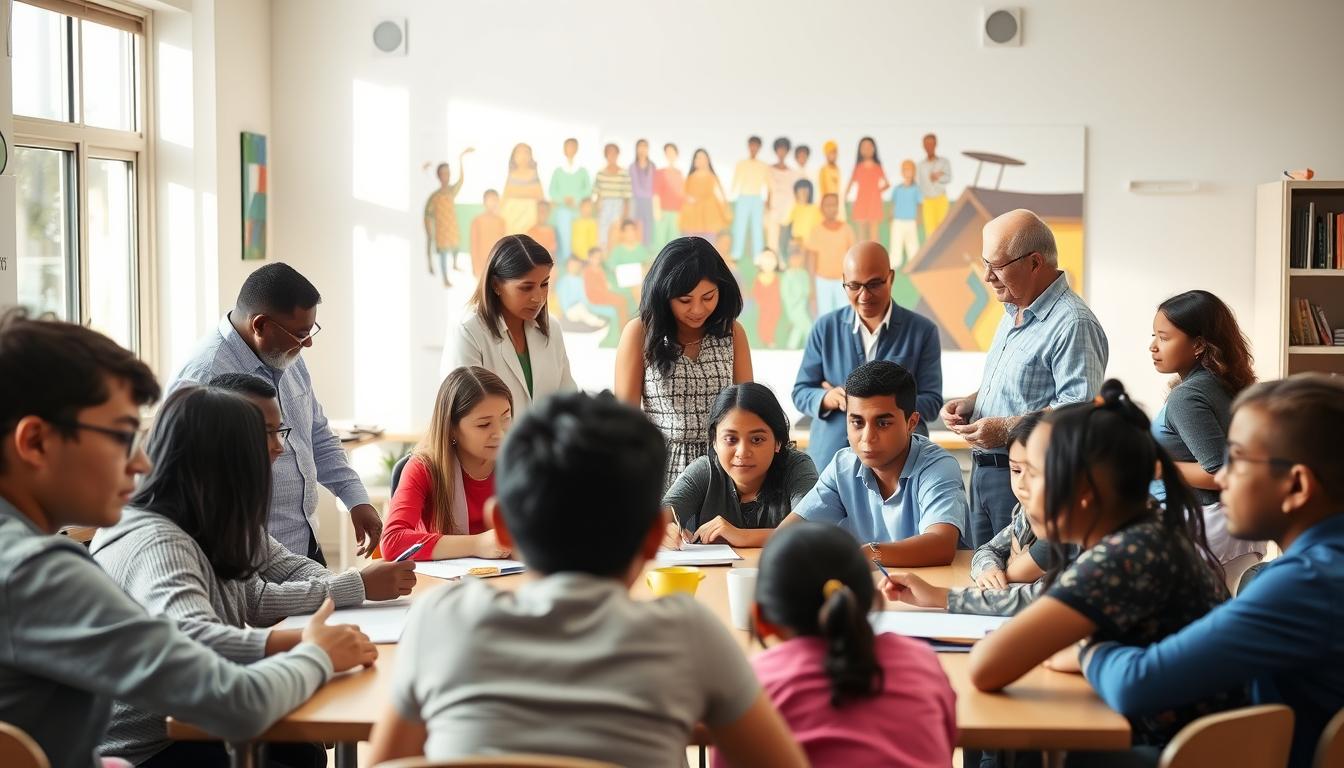Tech for Education: Leveraging Technology to Enhance Learning in Underserved Areas
In today’s world, digital learning is changing how we teach and learn. Using new teaching tools is key to better education. Tech for Education helps students in areas with less access to learning.
It brings new ways to learn and helps students get the skills they need. This technology makes learning better and opens doors to the future.
Understanding the Digital Divide in Education
The digital divide is a big problem in education. It shows how some students don’t have the same access to technology. This makes it hard for them to do well in school and get the skills they need for the future.
To really understand this issue, we need to look at what causes it and how it affects learning. It’s important to see how it impacts students from different backgrounds.
Definition of the Digital Divide
The digital divide is when some people have easy access to technology and the internet, but others don’t. It’s not just about having a connection. It also includes having devices, knowing how to use them, and being able to find and use online resources.
Fixing the digital divide is key to making sure all students have a fair chance to learn. It’s about making education equal for everyone.
Factors Contributing to the Digital Divide
Many things contribute to the digital divide. Money is a big factor, as students from poorer families often can’t afford devices or internet. Where you live also matters, as rural areas often have less access to technology.
How much money schools have also plays a part. If schools don’t have enough money, they can’t provide the technology needed for a good education.
The Impact on Student Learning
The digital divide has a big effect on how well students learn. Without the right technology, students can’t keep up in a world that’s more digital than ever. They miss out on interactive learning and important digital skills.
Studies show that students without good access to technology fall behind. It’s important to make sure everyone has equal access to technology to make education fair for all.
The Role of Technology in Modern Education
Technology has changed how students learn and access information. Now, they can use online tools to explore subjects deeply. This shows how important technology is in education, making learning better.
Enhancing Access to Educational Resources
Technology makes it easier for students to find educational materials. They can pick what works best for them. The main benefits are:
- More content like e-books, videos, and interactive sites.
- Current info from trusted sources on many topics.
- Students can learn on their own, making their education personal.
Fostering Engagement and Participation
Online tools help students get involved in their learning. They make learning fun and interactive. Key points are:
- Games and challenges that make learning fun.
- Feedback right away to see how they’re doing.
- Learning plans that fit each student’s needs.
Innovations in Educational Technology
Technology is changing how we learn in many places. Teachers are using new tools to help all students, especially those who need it most.
E-Learning Platforms and Tools
Platforms like Khan Academy and Coursera are making good education available to everyone. They have lots of courses, from simple to complex topics. These sites are easy to use, letting people learn at their own speed.
They also use videos and other media to make learning fun. This makes hard ideas easier to understand.
Interactive Learning Applications
Interactive apps make learning fun and engaging. They fit different learning styles, helping students learn better. For example, games in these apps keep students excited and motivated.
These apps help teachers create a fun learning space. They encourage students to work together and explore new things.
Virtual Classrooms
Virtual classrooms are key in today’s education, allowing students to learn from anywhere. Tools like Zoom and Google Classroom make it easy for teachers and students to connect. This makes learning possible for everyone, no matter where they are.
This technology also lets teachers try new ways of teaching. It supports group work, live discussions, and gives feedback right away.
The Benefits of Technology in Underserved Areas
Technology is key in shaping education, especially in areas with less access. It brings many benefits, improving learning for both students and teachers.
Improved Communication Between Educators and Students
Good communication is vital in schools. Modern tools help teachers stay in touch with students. This builds a supportive community.
Students can get help quickly through these tools. It makes learning more fun and effective.
Personalized Learning Experiences
Technology makes learning fit each student’s needs. It helps teachers understand how each student learns best. This leads to better understanding and grades.
Bridging the Gap in Resources
Technology is a big help in areas with less resources. It opens up a world of learning materials online. This gives students access to education they might not have otherwise.
Challenges to Technology Adoption
Bringing technology into schools is hard, especially in areas that need it most. We must understand these problems to find ways to make technology work better in schools.
Infrastructure and Connectivity Issues
One big problem is the lack of good internet in many places. In rural and poor areas, getting online is tough. Without it, students and teachers can’t use online tools or join digital classes.
Limited Training for Educators
Teachers also face a big challenge: not enough training on new tech. Many don’t know how to use new digital tools in class. This lack of knowledge makes them hesitant to try new things, slowing down progress.
Resistance to Change in Traditional Systems
Changing old ways of teaching is hard too. Many teachers and principals like what they know and are slow to try new tech. This makes it hard to bring new ideas into the classroom.
Success Stories: Tech Implementation Case Studies
Technology has changed schools and communities for the better. It has brought about amazing results in education. These stories show how tech can make learning better and more effective. Community efforts have also been key in making these changes happen.
Schools That Have Transformed with Tech
Many schools have welcomed technology to improve learning. They’ve used tools like interactive whiteboards and tablets. This has made lessons more fun and engaging.
For example, an urban school district saw big improvements. They used a mix of old and new teaching methods. This led to more students being interested in learning and better test scores.
Community Initiatives That Made a Difference
Local groups have played a big role in bringing tech to schools. They’ve worked to get internet to areas that didn’t have it. This has helped students use online learning tools.
They’ve also offered workshops on using technology wisely. This has helped families learn together. It’s made a big difference in how well students do in school.
Government Initiatives Supporting Tech in Education
Government programs are key in making technology a big part of schools. They work at both the federal and state levels. Their goal is to make sure every student gets to use the latest educational tools.
These efforts help bridge the digital divide. They aim to give all students a fair chance to learn.
Federal Programs and Policies
Federal tech initiatives set the stage for better technology in schools. The E-Rate program is a big help. It gives schools and libraries money for internet access.
This makes it cheaper for schools to go digital. Other policies help schools get the training they need. They encourage using new technology in teaching.
Local and State-Level Efforts
Local and state efforts focus on grants and partnerships. They help bring technology into classrooms. State budgets often include money for tech upgrades.
Districts work with tech companies to give schools the tools they need. This creates a better learning environment for everyone.
Partnerships and Collaborations
Working together, different groups in education make technology more available in places that need it most. These partnerships help create new ways to improve learning. They tackle problems schools face, giving them the tools they need.
When nonprofits team up with tech companies, amazing things happen. This shows how important it is to work together in education.
Nonprofits and Educational Technology Companies
Nonprofits are key in getting technology to schools. Groups like Teach For America partner with tech companies to offer special solutions. They help teachers learn how to use technology in the classroom.
This teamwork means schools get new tools. Students then get a better education, even when resources are limited.
Universities Working with Schools
Universities and schools working together is very important. They help solve problems in education through research and development. This partnership brings together the knowledge of universities and the needs of schools.
Together, they create programs that use technology to improve learning. This is a powerful way to make education better for everyone.
The Importance of Digital Literacy
Digital literacy is key in today’s education. It helps students use technology and get ready for the modern job market. As we move into the digital age, teaching these skills is vital for students’ success.
Teaching Skills for the Future
Adding digital literacy to school curricula means teaching students to use digital tools well. They learn:
- How to search the internet effectively.
- Safe ways to communicate and work together online.
- How to use digital tools to solve problems.
This training helps students think critically and be creative. It prepares them to be more than just users of technology. They become creators and innovators.
Preparing Students for a Technology-Driven Workforce
The job market today needs people who know how to use technology. Schools must teach both technical and soft skills like teamwork and flexibility. They can do this by:
- Using digital tools in project-based learning.
- Encouraging teamwork through technology.
- Offering resources for self-learning.
By teaching both technical and soft skills, schools can make students ready for the workforce. This prepares them for success in their future careers.
Measuring the Impact of Technology in Education
To understand how well technology works in schools, we need a detailed look. We must see how it changes learning results. This helps schools pick the right tools for their students.
Collecting and studying data is key. By looking at how students use technology, how engaged they are, and their grades, we learn a lot. This helps us see if technology really helps students do better.
Data Collection and Analysis
Good measurements start with collecting the right data. Schools use surveys, test scores, and how often students participate. This helps them see if technology is making a difference.
They look at how students use digital tools and compare it to their grades. This way, they can make technology better for learning.
Long-Term Outcomes for Students
Technology in schools has many benefits over time. It can lead to more students graduating and doing well on tests. Schools that use technology see students more involved and staying in school longer.
By watching these changes, we see how technology can really help students. It shows the good things technology can do in schools.
The Future of Educational Technology
Education is changing fast thanks to new tech. The future of edtech is bright, with many trends and innovations. These will make learning better and prepare students for what’s next.
Upcoming Trends and Innovations
Artificial intelligence is a big deal in education. It can make learning materials fit each student’s needs. Augmented reality will bring subjects to life, making learning fun and interactive.
Gamification in education is also exciting. It makes learning fun and keeps students motivated. This approach makes learning more enjoyable and effective.
Predictions for the Next Decade
The next decade will bring big changes in education. Tech will make learning more accessible to everyone. This will help reach students who are currently left behind.
New tech will also offer more learning options. This will make education fair for everyone. It shows how important tech is in making education better for all.
How to Advocate for Technology in Education
Advocating for educational technology is key to closing the gap in access and resources in underserved areas. It’s important to work with a wide range of stakeholders, like teachers, parents, and policymakers. This way, advocates can build a strong group that supports investing in technology and shows how it improves learning.
Starting a conversation about the benefits of technology in schools is a good first step. Sharing success stories and data can help others see how technology can change education. Also, talking openly about concerns and challenges can lead to finding solutions that meet community needs.
Getting the community on board and aware of the need for technology is also crucial. Events like workshops, meetings, and social media campaigns can help. By getting more people involved, advocates can create a space where technology is seen as essential for better education for all.
FAQ
What is the digital divide in education?
How can technology improve access to educational resources?
What are some examples of innovative teaching tools?
What benefits does technology bring to underserved educational areas?
What challenges are faced when adopting technology in education?
How can communities support the implementation of technology in schools?
What is the significance of digital literacy for students?
How can the impact of technology in education be measured?
What are some future trends in educational technology?
Published on: 28 de February de 2025

Luke Martin
Luke Martin, author of Credwallets.com, is a mathematics graduate with a specialization in financial markets. Known for his love of pets and his passion for sharing knowledge, Luke created the site to provide valuable insights into the complexities of the financial world. His approachable style and dedication to helping others make informed financial decisions make his work accessible to all, whether they're new to finance or seasoned investors.







